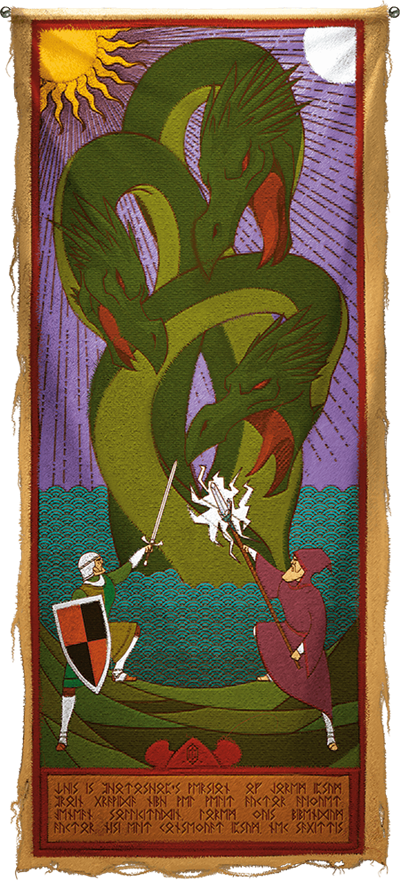 We’ve completed our second full rotation of the twelve classes in the Player’s Handbook, not to mention taken a deep dive into the first 5 levels of D&D’s thirteenth class, the inventive and arcane Artificer! This wave of the Class 101 series will appraise every subclass within the Player’s Handbook and break down each subclass’s strengths, weaknesses, thematic elements, and everything else a player would want to know before playing that subclass. Because of this, you will need to own the Player’s Handbook (or purchase the subclass a la carte on the Marketplace) in order to make full use of this series.
We’ve completed our second full rotation of the twelve classes in the Player’s Handbook, not to mention taken a deep dive into the first 5 levels of D&D’s thirteenth class, the inventive and arcane Artificer! This wave of the Class 101 series will appraise every subclass within the Player’s Handbook and break down each subclass’s strengths, weaknesses, thematic elements, and everything else a player would want to know before playing that subclass. Because of this, you will need to own the Player’s Handbook (or purchase the subclass a la carte on the Marketplace) in order to make full use of this series.
The fighter class is one of the most thematically versatile classes in Dungeons and Dragons. That is to say, while classes like paladin or warlock impose a certain level of roleplaying flavor on your character from the very beginning, a fighter is more or less a blank canvas for your own character’s story. When playing an Eldritch Knight, a type of fighter that uses weapons and destructive spells in conjunction, you’re free to determine how you gained your martial and magical skills, and what you want to achieve with them.
Check out the other guides in the Class 101 series, like the broad overview of the druid class in Fighter 101: A Beginner’s Guide to Heroic Combat, Fighter 101: Champion, and Fighter 101: Battle Master. If you’re interested in playing other classes, check out the entire Class 101 series.
Story of the Eldritch Knight
“What are you doing?” a young brother asked his sister. The sister, a fighter, knelt before a makeshift altar cobbled together by wooden boards atop two sawhorses, draped with a simple burlap cloth. A longsword rested on the altar. Her eyes were closed, and she was dressed in a simple tunic and breeches, her hair pulled into a bun. The suit of armor she had inherited from her father hung on a stand nearby. Her brow twitched with annoyance as her brother spoke.
“I’m meditating,” she grumbled. She let out a long breath and reached out into the aether once more with her consciousness, feeling for the strands of the Weave that were strung invisibly around her. She hovered her open hand over the hilt of sword, and felt new strands of magic forming between the wellspring of magic within her and the sword.
“Can I help?” her brother, bounding to her side, a huge grin on his face. “You meditating with that sword? You gonna do magic? Can I see? Can I see your magic?”
The sister scowled and growled through gritted teeth, “If you can sit still for ten minutes, yes.”
Miraculously, he was. He sat cross-legged next to his kneeling sister, alternating between gawking at the look of calm concentration on her face and the gently humming sword on the homemade dais before her. Ten tense minutes passed, and the fighter’s eyes snapped open. A flash of light glinted upon her irises, and then vanished just as quickly as it appeared. She stood and flexed her trembling hand.
“Okay,” she said to her brother, pointing to the sword. “Take it.”
“Really?” her brother gasped, eyes wide and shining with excitement.
“Yeah, really,” the fighter said, looking away. “Just watch the blade and don’t hurt yourself. Or, if you do hurt yourself, say you were playing in the forest. Mom’ll kill me otherwise.”
“Whoo hoo!” her brother whooped. He picked up the sword and swung it into the air over his head. He ran around the cellar room, slashing at invisible foes and imagining he was just like their father, killing monsters that threatened their village. His sister smiled at his excitement, then focused herself. She focused her eyes upon the hilt of the sword as her brother ran about and steadied her breathing. She tuned out all the distractions of the Material Plane and focused solely upon the strands of the Weave that bound her to the blade. She felt a surge of energy tingle from her chest down her arm, and at the moment the surge passed through her fingertips, the sword vanished from her brother’s hands.
Her brother yelped and looked around. “Ahhh! It’s gone!” he gasped. “I’m so sorry, it just—!” He turned to his sister and his jaw dropped open. Clutched in his sister’s right hand was her father’s sword. Her heart was pounding as she stared at the sword she had just magically conjured to her, but she managed to compose herself and look at her brother with a flicker of smugness.
“See?” she said. “Magic.”
Eldritch Knight Features
Eldritch Knight fighters memorize a number of destructive and protective spells during their training, in addition to other magical abilities that allow them to meld their martial and magical prowess. The fighter gains access to five subclass features at 3rd, 7th, 10th, 15th, and 18th level. You can read all of the Eldritch Knight features in the Player’s Handbook. In summary, your subclass features allow you to:
- You learn two cantrips from the wizard spell list
- You gain the ability to memorize and cast a number of abjuration and evocation spells from the wizard spell list
- You bond with your weapon, allowing you to summon it to your hand at any time
- You can make a weapon attack as a bonus action when you cast a cantrip
- Your weapon attacks make creatures less likely to succeed on saving throws against your spells
- You can teleport short distances when you use your Action Surge feature
- You can make a weapon attack as a bonus action when you cast a spell as an action
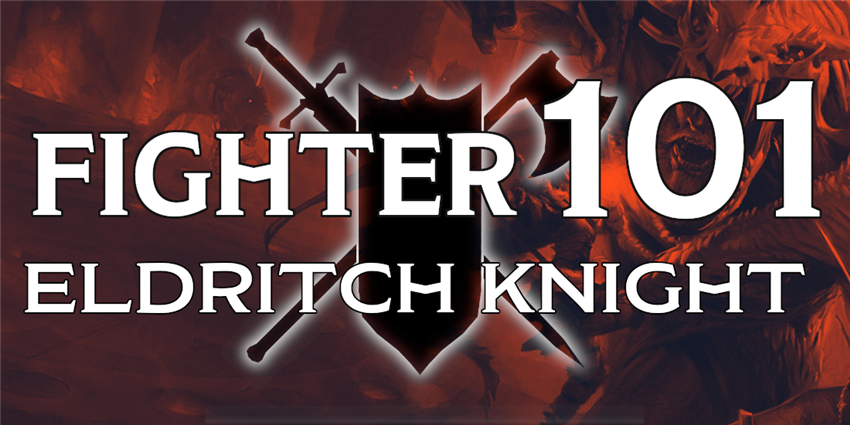
Benefits of the Eldritch Knight
There are a number of different options available for people who want to wield both spells and weapons—what does the Eldritch Knight bring to the table? The paladin offers a “jack of all trades” option by combining heavy armor and spiky damage through Divine Smite, the bardic College of Valor and clerical Light Domain provide spell-heavy options for moderately armored warriors, and the Bladesinger wizard tradition encourage lightly armored warriors to dance into battle, supported by their mighty spells.
Eldritch Knights curve in the opposite direction, using spells to complement their impressive suite of powerful defenses and overwhelming attacks. Typically, fighters can only focus on single targets with their attacks, and struggle against foes whose armor shrugs off these attacks. This encourages a very specific playstyle for Eldritch Knights: focus on spells that target multiple foes (or that effect an area), and find spells that force enemies to make a saving throw instead of requiring you to make an attack roll.
Your spells are situational tools, and the limited number of spell slots you get per day are a stark reminder of this. Don’t forget: you’re still a fighter first. Stay in the thick of combat, bashing helmets and tanking blows until your enemies have all clumped up around you, then let loose a well-timed burning hands to maximum effect. If you want to add a little more variety to your repertoire than evocation (offensive) or abjuration (defensive) spells can offer, you can add a spell from any school of magic to your list of Spells Known at 8th, 14th, and 20th level.
As you gain levels in this class, your class features will help make you more flexible. Generally, you’ll have to choose between making an attack and casting a spell on a given turn. Features like War Magic, Eldritch Strike, and Improved War Magic make this choice much less painful by letting you cast spells and make an attack in the same turn—and even giving you a benefit to doing so against the same foe.
Drawbacks of the Eldritch Knight
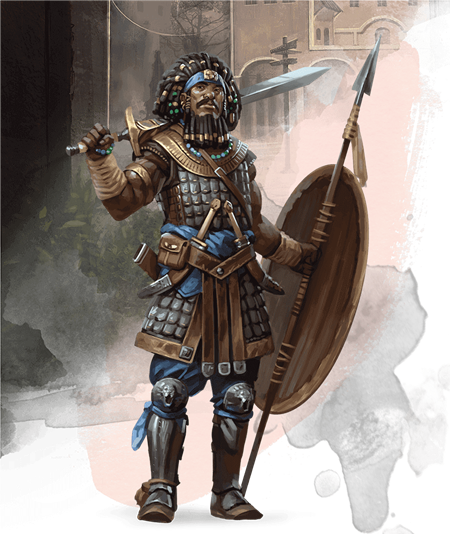 The biggest challenge of playing an Eldritch Knight is a conflict between casting spells and making attacks. These two styles of D&D combat mix like water and oil, and it’s difficult to meld them together in a way that evokes the fluid feelings of magically enhanced martial combat in popular fantasy series like Avatar: The Last Airbender or Star Wars. Casting a spell and making a weapon attack are two discrete actions; unless you’re using a purpose-made cantrip like green-flame blade, you can’t weave magic into a sword strike.
The biggest challenge of playing an Eldritch Knight is a conflict between casting spells and making attacks. These two styles of D&D combat mix like water and oil, and it’s difficult to meld them together in a way that evokes the fluid feelings of magically enhanced martial combat in popular fantasy series like Avatar: The Last Airbender or Star Wars. Casting a spell and making a weapon attack are two discrete actions; unless you’re using a purpose-made cantrip like green-flame blade, you can’t weave magic into a sword strike.
Spells that can be cast as a reaction or a bonus action, like misty step or shield, soften this issue somewhat, allowing you to make an attack and then repel your foes’ strikes with a shimmering barrier of force. Nevertheless, it can be frustrating to have to page through a list of abjuration or evocation spells with a casting time of 1 reaction or 1 bonus action to find what spells will support the character concept you have in your head.
At least that sort of research digitally is much easier than doing so with a print book, thanks to the D&D Beyond Spell tool—which, troublingly, reveal the limits of this restriction: there are only three 1-reaction-casting-time spells that fit those criteria, and no 1-bonus-action-casting-time spells. So, while the Eldritch Knight is a reasonably powerful class, the challenges of melding spellcasting and sword fighting into one fluid motion may frustrate you if you’re looking for a highly cinematic experience in your D&D game.
If you want to be able to cast spells and fight, but you’re playing a low-level one-shot or don’t think your campaign will advance past 6th level, you might be better off playing a Champion fighter and taking Magic Initiate (Wizard) feat, granting you two wizard cantrips and one 1st-level wizard spell that you can once per long rest. Your spellcasting will be much more limited than if you’d chosen to play an Eldritch Knight—at 5th level, an Eldritch Knight knows two cantrips but also knows 4 wizard spells and has three 1st-level spell slots with which to cast them. However, if giving your fighter a little bit of magical flavor is all you want, then Champion’s suite of simple, powerful combat-focused features might be more appealing.
Suggested Build
Like most classes in D&D, the fighter doesn’t choose their subclass until 3rd level. If you’re playing a fighter from 1st level and think you want to become an Eldritch Knight later, you should choose a race that improves your Strength (or Dexterity) score and also your Intelligence score. Strength affects how hard you hit with most melee weapons, whereas Dexterity makes you better with ranged or finesse weapons. Your Intelligence score affects how likely you are to hit with your spell attacks, and how high your spell save DC is, which makes it harder for foes to resist your spells. Because of this, your Strength or Dexterity score should be your highest ability score, and your Intelligence should be your second highest score.
You can play an Eldritch Knight as a heavily armored, greatsword-wielding tank, or as a lithe and nimble, rapier-wielding duelist. If you want to play the former, some good races include half-orc, dragonborn, rock gnome, and mountain dwarf. To play the latter, races like forest gnome and high elf will do the trick. Humans and half-elves are well-suited to just about any class, as well.
As usual, your character’s background is up to you. You can come up with all sorts of interesting stories and oddball characters by pairing unlikely backgrounds with the Eldritch Knight’s particular blend of sagely study and rough-edged athleticism. Were you a Sage who abandoned a rigorous regimen of “useless” magical study to practice destructive arts instead? Or were you a Noble whose tutors encouraged you to dabble in many different forms of martial artistry?
It’s a safe bet to choose EQUIPMENT when given the choice between GOLD or EQUIPMENT during character creation. The various types of equipment available to fighters easily suits either a Strength or Dexterity-focused playstyle. Choose chain mail and a martial weapon plus a shield if you want to focus on Strength, and choose leather armor, a longbow, and a rapier if you want to focus on Dexterity. Since you will gain class features that allow you to make weapon attacks as a bonus action when you cast a spell, you should focus on wielding a shield and a rapier if you want to be a Dexterity-based fighter, rather than dual wielding light weapons.
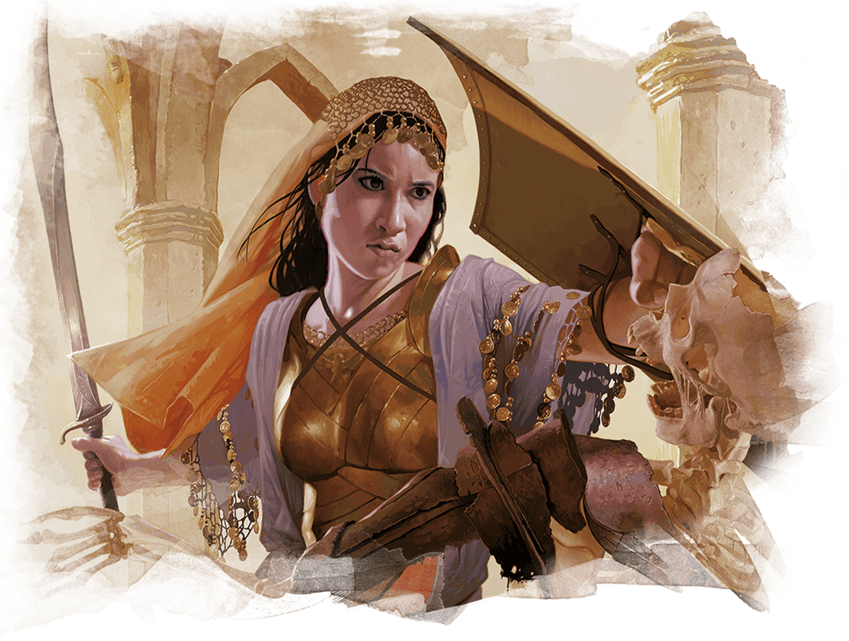
Spells
You gain the ability to cast spells when you choose this subclass at 3rd level. Your spell selection is quite limited—not only do you memorize spells instead of being able to prepare them at the start of a day, but you only have a scant two 1st-level spell slots to use. While this number increases as you level up, it encourages you to reserve your spells for big, flashy moments of destruction, or in desperate last-ditch efforts.
As a 3rd-level Eldritch Knight fighter, you know two cantrips from the wizard spell list. Since you’re likely to be in melee combat, it’s good to choose one offensive cantrip with a range of at least 60 feet to extend your reach. Your second cantrip should be either a utility cantrip to help round out your character’s skill set, or an offensive cantrip with a range of 5 feet, so that you don’t have to worry about having disadvantage when making a ranged attack while in close combat.
Also at 3rd-level, you know three spells: two 1st-level abjuration or evocation spells from the wizard spell list, and one 1st-level spell of any school from the wizard spell list. Choose these spells wisely; though you can trade out one spell you know for another when you gain a level in this class, these spells are otherwise permanent decisions. It’s wise to know at least one spell labeled OFFENSE and one labeled DEFENSE, and choose your third spell based on what you think your character would want to know. Note that this list only includes some spells from the Player's Handbook, so if you want to choose more unusual spells, or have other sources like Xanathar's Guide to Everything, you'll have to do a little self-directed research. This list is just here to get you started if this is your first time playing an Eldritch Knight.
- Alarm (SUPPORT)
- Burning hands (OFFENSE)
- Chromatic orb (OFFENSE) [be aware that you’ll have to purchase a diamond worth 50 gp in order to cast this powerful spell!]
- Magic missile (OFFENSE)
- Protection from evil and good (DEFENSE)
- Shield (DEFENSE)
- Thunderwave (OFFENSE)
Feats
As a fighter, you gain two more Ability Score Increases than any other class in the game. (The extras come at 6th and 14th level.) This means that it’s incredibly easy for you to take one or even two feats while still maxing out your vital ability scores!
Once you’ve improved your Strength or Dexterity score to 18 or 20, you can increase your power with a few useful feats. The following feats are good picks for Eldritch Knight fighters, and will improve your reliability in your own desired area of expertise:
Great Weapon Master. These days, it practically goes without saying that Great Weapon Master is one of the best feats in the game. Choosing this feat will send your damage output into the stratosphere, though only if you’re using a two-handed weapon.
Polearm Master. This feat synergizes well with War Caster and Sentinel, making it difficult for enemies to approach you or maneuver around you.
Sentinel. A must-have feat for any fighter interested in tanking for their party, Sentinel makes it hard for enemies to attack your allies, or for them to leave your reach once they’ve approached you.
Shield Master. A specialized but useful choice for Eldritch Knights who want to wield a shield rather than go for a two-handed weapon. An excellent choice for Dexterity-focused fighters wielding a rapier and a shield.
War Caster. Eldritch Knights, especially those who wield a one-handed weapon and a shield, can make use of every aspect of this feat. Making it easier to maintain concentration while taking damage is always a benefit, and not having to have a hand free to perform a spell’s somatic components is a huge boon when you can't afford to drop your shield or your rapier. Gaining the ability to make opportunity attacks with your spells is also excellent! Just imagine hurling a guaranteed-to-hit magic missile at a fleeing foe.
If you want more advice for building a fighter, check out Fighter 101. Have you ever played an Eldritch Knight fighter? What advice would you give to players that want to play this subclass? Next week, Class 101 will cover the monk's Way of Shadows archetype, an unseen ascetic who strikes from the shadows. What's your fighter character like? Let us know in the comments!
Create A Brand-New Adventurer Acquire New Powers and Adventures Browse All Your D&D Content
 James Haeck is the lead writer for D&D Beyond, the co-author of Waterdeep: Dragon Heist, Baldur's Gate: Descent into Avernus, and the Critical Role Explorer's Guide to Wildemount, a member of the Guild Adepts, and a freelance writer for Wizards of the Coast, the D&D Adventurers League, and other RPG companies. He lives in Seattle, Washington with his fiancée Hannah and their animal companions Mei and Marzipan. You can find him wasting time on Twitter at @jamesjhaeck.
James Haeck is the lead writer for D&D Beyond, the co-author of Waterdeep: Dragon Heist, Baldur's Gate: Descent into Avernus, and the Critical Role Explorer's Guide to Wildemount, a member of the Guild Adepts, and a freelance writer for Wizards of the Coast, the D&D Adventurers League, and other RPG companies. He lives in Seattle, Washington with his fiancée Hannah and their animal companions Mei and Marzipan. You can find him wasting time on Twitter at @jamesjhaeck.








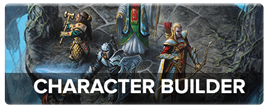
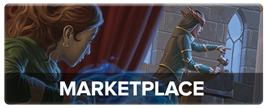
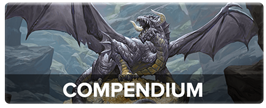
-
View User Profile
-
Send Message
Posted Sep 5, 2020A good editor, fact checker, or proofreader is worth double their salary.
-
View User Profile
-
Send Message
Posted Sep 5, 2020Or, just use a melee attack or a spell that doesn't call for a ranged attack, rather than paying full price for a third of a feat. Plenty of good spells based on saves rather than attack rolls.
-
View User Profile
-
Send Message
Posted Sep 5, 2020You're not wrong, but it's still an option when you take into consideration damage weaknesses and resistances. A firebolt might be more preferable against AC than a saving throw, and might be a better general fire cantrip than Green-Flame Blade as it has that 120 ft range.
Obviously dependant on how you want to build the character, of course.
-
View User Profile
-
Send Message
Posted Sep 5, 2020If you need to attack at range you already get a light crossbow as standard equipment which is perfectly good for that (or swap for a Longbow when you can so you can use your extra attacks without needing a feat). If you're going to take ranged damage spells then you should go for ones that force saving throws as that gives you options for when you're confronted with high AC (or enemies with Shield).
-
View User Profile
-
Send Message
Posted Sep 5, 2020I would only bother taking a bow or crossbow if you're running a dex based character to begin with. If not, using a cantrip is probably going to give you better attack and damage potential.
-
View User Profile
-
Send Message
Posted Sep 6, 2020Your snark is unwarranted; there are no wizard cantrips that don't have a casting time of 1 action. Even if you were to use a feature like War Caster to cast a cantrip as a reaction, you can't use a bonus action when it isn't your turn. I can imagine an edge case where a creature has a reaction that allows it to move on your turn, you use your reaction to make an opportunity attack, and technically have a bonus action available for use, but this isn't an edge case guide. This is a 101 guide to give people a broad understanding of a class's features, not an exhaustive list of how the class works—you'll need to buy the Player's Handbook for that.
-
View User Profile
-
Send Message
Posted Sep 6, 2020Great Article! I've always wanted to play an eldritch knight, but I was worried because (I am usually a spellcaster class) i'd have to struggle through two levels of just weaponry too get to just a tiny bit of magic. also, this subclass gives me a chance to try out some races I have not played yet: Gnome and High Elf. Also, can you do a: Rogue 101: Arcane trickster?
-
View User Profile
-
Send Message
Posted Sep 6, 2020As far as I know, there are no cantrips that don't have a casting time of one action full stop.
The only way to change that is with sorcery points and quicken spell.
Edit: And Warcaster feat.
-
View User Profile
-
Send Message
Posted Sep 6, 2020Only if you're expecting to be frequently trapped in ranged shootouts, which an Eldritch Knight shouldn't want to be (unless they're DEX based with a bow/crossbow in which case, use the bow/crossbow as I said).
Most Eldritch Knights are going to be melee based as that's the better option for a tanky character, at which distance ranged attack spells become useless, which is why it's better to take those that force a save instead, as you can use those in melee range without penalty.
Basically the argument is that ranged attack spells on a melee focused character will limit your spell options in melee, whereas save-based ranged spells will not.
-
View User Profile
-
Send Message
Posted Sep 6, 2020My favorite character is an eldritch knight!
I play mine with true strike cantrip and elven accuracy feat with my rapier for a 3d20 attack roll. it's not more powerful that simply attacking with extra attack but it's mostly for roleplaying as it becomes maximum omae wa mou shindeiru anime finisher attack.
-
View User Profile
-
Send Message
Posted Sep 6, 2020Notice that I did not specify whether to use a cantrip that made a ranged attack or a forced a saving throw.
-
View User Profile
-
Send Message
Posted Sep 6, 2020" Gaining the ability to make opportunity attacks with your spells is also excellent! Just imagine hurling a guaranteed-to-hit magic missile at a fleeing foe."
I'm not entirely sure Magic missile is a valid spell for that, because it can target more than one creature. I'll have to look this up, but I remember reading that somewhere......
-
View User Profile
-
Send Message
Posted Sep 6, 2020I loved this article, some of my First and best memories are of playing a dragonborn eldritch knight. The great weapon master works wonderfully with it as you become a monster in combat and as a dragonborn I had a breath attack once per long rest which could remove clumps of enemies if I need. This let me focus on more defensive spells as well.
But with a returning weapon combats become much more dynamic, this works best if you choose a thrown weapon, I prefer hand axes, as you can get it back at low levels to throw on your next turn. An extra long range spell and area effects compliment this nicely as well so hordes don't become a problem and anyone outside the thrown range of your weapon can get sniped by your spell.
*a side note to dm's, if the party has an eldritch knight in the party and you lock them up prison breaks become much easier for them as they can teleport their weapon back to them instead of finding it.
-
View User Profile
-
Send Message
Posted Sep 6, 2020It should be valid, as you can choose to target only that creature with all the missiles. A second target (or non-creature target, or no target) is not required to successfully cast Magic Missile.
-
View User Profile
-
Send Message
Posted Sep 6, 2020A prison in any decently sized town should have low-level magic suppression, else every hedge mage & cultist that gets thrown in there will be casting cantrips all day long. Blocking Misty Step, Invisibility, and other low level "get out of jail free" cards should be considered baseline security in a world with magic.
Or if that's considered too expensive, then they don't jail known magic users, they cut off hands, gouge out eyes, and so on. A government that can't maintain order will be replaced quickly with one that can.
-
View User Profile
-
Send Message
Posted Sep 6, 2020My personal preference for starring spells on an Eldritch Knight are:
Cantrips - Booming Blade and Green-flame Blade
1st level - Feather Fall, Magic Missile, and Shield.
I also like to squeeze the Magic Initiate (Wizard) feat somewhere in the build.
-
View User Profile
-
Send Message
Posted Sep 6, 2020Antimagic Field is an 8th-level spell, so I'm curious as to how you define a "decently sized town."
And any government that resorts to such draconian methods is oppressive and begging to be toppled by upstart adventurers.
-
View User Profile
-
Send Message
Posted Sep 6, 2020Love my Eldritch Knight, human variant with the polearm feat. Playing in AL games, I kept thinking I’d take two levels of war wizard but fighter features are so great I’ve gotten to 14th level and still haven’t. Booming blade with a polearm is fun; shield, protection from evil/good, and mirror image are his go to spells. You get to pick a non abjuration/evocation spell every few levels and those are some of the most useful (like find familiar and mirror image). Casting haste on yourself’s pretty fun, too. The occasional AOE is pretty handy, but with three attacks per round and a bonus is polearm strike I tend to use only one spell at the beginning with action surge, then stick with reactions the rest of the fight. Counterspelling enemy spellcasters as a fighter is pretty great, too.
-
View User Profile
-
Send Message
Posted Sep 7, 2020I never stated how they made the cells proof or resistant to magic, so while I agree that access to a 8th level spell isn't common, there needs to be some way to keep beings with minor magical abilities well behaved.
If you can't enforce the laws, someone who can will show up sooner rather than later, and take over, instituting their own laws. It may be a dragon, or a criminal outfit, or a group of adventurers, but there will always be someone with power & ambition looking to be king of the hill. And I recommend checking out Dark Sun, if you think cutting off the hands of thieves & pickpockets is oppressive.
-
View User Profile
-
Send Message
Posted Sep 7, 2020that's just a really common house rule. saying you can. the rules don't take into account that you can hold a great sword with one hand